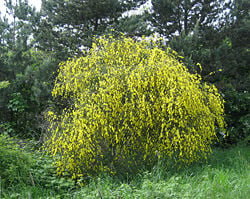Shrub
A shrub or bush is a horticultural rather than strictly botanical category of woody plant, distinguished from a tree by its multiple stems and lower height, usually less than 6 m tall. A large number of plants can be either shrubs or trees, depending on the growing conditions they experience. Small, low shrubs such as lavender, periwinkle and thyme are often termed subshrubs.
Note:Trees are the largest plants. They are not a single taxon (unit of biological classification) but include members of many plant taxa. A tree can be defined as a large, perennial (living more than one or two years), woody plant. Although there is no set definition regarding minimum size, the term generally applies to plants at least 6 meters (20 feet) high at maturity and, more importantly, having secondary branches supported on a single, woody main stem or trunk.
Note: Compared with most other plant forms, trees are tall and long-lived. A few species of trees grow to 100 meters tall, and some can live for several thousand years.
A natural plant community dominated by shrubs is called a shrubland. The word bush can also refer to a type of plant community, as in the Australian bush. This is often characterised by scrubby, open woodland and is a generic term for Eucalyptus dominated woodland in particular.
An area of cultivated shrubs in a park or garden is known as a shrubbery. When clipped as topiary, shrubs generally have dense foliage and many small leafy branches growing close together. Many shrubs respond well to renewal pruning, in which hard cutting back to a 'stool' results in long new stems known as "canes". Other shrubs respond better to selective pruning to reveal their structure and character.
Shrubs in common garden practice are generally broad-leaved plants, though some smaller conifers such as Mountain Pine and Common Juniper are also shrubby in structure. Shrubs can be either deciduous or evergreen.
Note: Trees are important components of the natural landscape and significant elements in landscaping and agriculture, supplying orchard crops (such as apples and pears). Trees are important for other plants, for animals, and for the entire web of life on earth, including humans. Trees also play an important role in many of the world's religions and mythologies.
List of shrubs (bushes)
Those marked * can also develop into tree form.
|
|
|
External links
- Selecting Shrubs for Your Home (University of Illinois Extension)
Credits
New World Encyclopedia writers and editors rewrote and completed the Wikipedia article in accordance with New World Encyclopedia standards. This article abides by terms of the Creative Commons CC-by-sa 3.0 License (CC-by-sa), which may be used and disseminated with proper attribution. Credit is due under the terms of this license that can reference both the New World Encyclopedia contributors and the selfless volunteer contributors of the Wikimedia Foundation. To cite this article click here for a list of acceptable citing formats.The history of earlier contributions by wikipedians is accessible to researchers here:
The history of this article since it was imported to New World Encyclopedia:
Note: Some restrictions may apply to use of individual images which are separately licensed.
